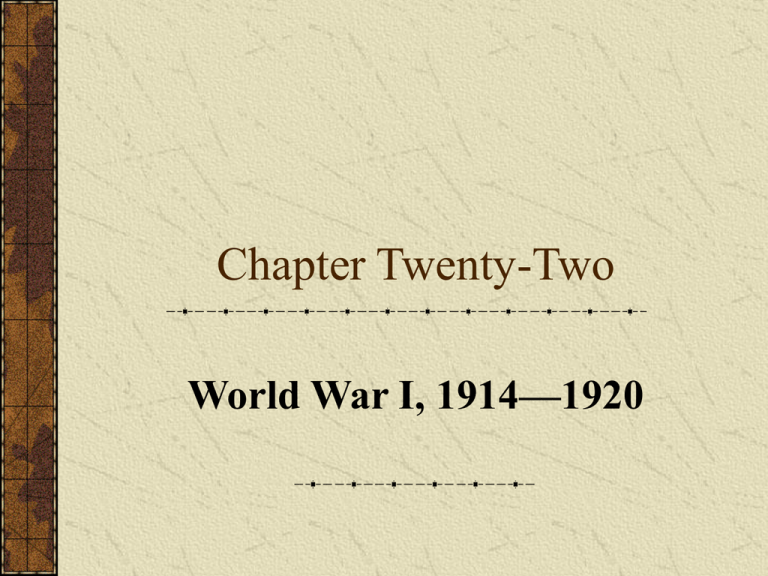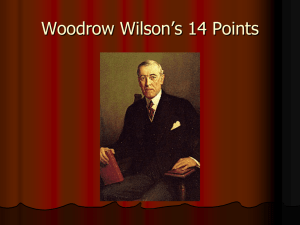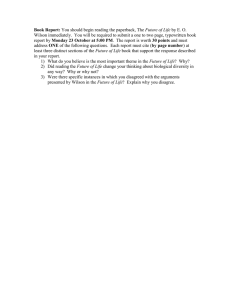Chapter Twenty-Two World War I, 1914—1920
advertisement

Chapter Twenty-Two World War I, 1914—1920 Part One: Introduction World War I How does this painting reflect American opinion on World War I? Chapter Focus Questions How did America’s international role expand? How did the United States move from neutrality to participation in the Great War? How did the United States mobilize the society and the economy for war? How did Americans express dissent and how was it repressed? Why did Woodrow Wilson fail to win the peace? Part Two: American Communities Vigilante Justice in Bisbee, Arizona The radical Industrial Workers of the World (“Wobblies”) organized a peaceful strike that won support from over half the town’s miners in 1917. Armed men began rounding up strikers at a copper mine in Bisbee, Arizona. The sheriff and town’s businessmen justified vigilantism by invoking patriotism and racial purity. Of the 2,000 men kept under armed guard, 1,400 refused to return to work and were taken on a freight train to a small town in the desert. Neither the federal nor the state government would act. The Arizona mines operated without unions into the 1930s and with very few immigrant workers. Part Three: Becoming a World Power Roosevelt: The Big Stick Americans believed that they had a God-given role to promote a moral world order. Theodore Roosevelt’s “big stick” approach called for intervention. He secured a zone in Panama for a canal, completed in 1914. He expanded the Monroe Doctrine to justify armed intervention in the Caribbean where the United States assumed management of several nations’ finances. In Asia, the United States pursued the “Open Door” policy. TR mediated a settlement of the Russo-Japanese War. Taft: Dollar Diplomacy Map: The U. S. in the Caribbean Roosevelt’s successor, William Howard Taft, favored “dollar diplomacy” that substituted investment for military intervention. Taft believed that political influence would follow increased U.S. trade and investments. American investment in Central America doubled. Military interventions occurred in Honduras and Nicaragua. In Asia, the quest for greater trade led to worsening relations with Japan over the issue ownership of Chinese railroads. Wilson: Moralism and Realism in Mexico Woodrow Wilson had no diplomatic experience before becoming president. He favored expanding the Open Door principle of equal access to markets. He saw expansion of American capitalism in moral terms. The complex realities of power politics interfered with his moral vision. Unable to control the revolution in Mexico, Wilson sent troops to Vera Cruz and northern Mexico. When relations with Germany worsened, Wilson accepted an international commission’s recommendation and withdrew U.S. troops from Mexico. Part Four: The Great War The Guns of August Competition between Britain and Germany had led to competing camps of alliances. The Triple Alliance (Central Powers): Germany, Italy, and Austria-Hungary The Triple Entente (Allied Powers): England, France, and Russia The alliances prevented small problems but threatened to entangle many nations in any war that erupted. The assassination of the Archduke of Austria by a Serbian nationalist in 1914 escalated into a general war. Germany had pushed Austria to retaliate against Serbia. Serbia was under the protection of Russia. If Serbia was attacked, Russia would enter the conflict, bringing England and France as well. American Neutrality Wilson and most Americans wanted to stay neutral. Many Americans had Old World ties. The English and Germans bombarded Americans with propaganda. Economic ties hurt American neutrality. Wilson opposed the British blockade of Germany but did not trade with the Germans. Trade with the Allies increased dramatically. Preparedness and Peace Germany declared the waters around Britain to be a war zone and began submarine attacks. In May 1915 Germans sank the Lusitania, a British passenger ship secretly loaded with armaments, killing 1,198 people including 128 Americans. In March 1916, Germany changed its submarine policy, but Wilson pushed for greater war preparation. Opponents mobilized on the streets and in Congress. In 1916, Wilson won re-election with the slogan “He Kept Us Out of War.” Safe for Democracy Germans resumed unrestricted submarine warfare in February 1917 gambling that they could destroy the Allies before America intervened. Wilson broke diplomatic relations with Germany. The White House publicized a note from the German foreign secretary to Mexico which proposed an alliance with Mexico if the United States entered the war. The Zimmerman note provoked an outpouring of antiGerman feeling. Wilson issued an executive order authorizing the arming of merchant ships and allowing them to shoot at submarines. In one month German U-boats sank seven merchant ships. On April 6, 1917, Congress declared war. Part Five: American Mobilization Selling the War Uncertain about public backing for the war, Wilson appointed George Creel to head the Committee on Public Information that tried to promote public support. Creel enlisted over 150,000 people to promote the cause. The CPI: published literature sponsored huge rallies featuring movie stars portrayed America as a unified moral community engaged in a crusade for peace and freedom depicted Germans as bestial monsters Fading Opposition to War Many progressives and intellectuals identified with Wilson’s definition of the war as a defense of democracy. Women’s suffrage leaders who had initially opposed war preparedness threw themselves behind the war effort. The war effort gave women a leading role in their communities selling war bonds, coordinating food conservation drives, and working for hospitals and the Red Cross. Many hoped that supporting the war effort would help the suffrage cause. Only a minority maintained their opposition to the war. “You’re in the Army Now” Recruiting a large army required a draft that met with only scattered organized resistance. On the first day, nearly 10 million men registered for the draft. By the end of the war 24 million had registered, 2.8 had been called to serve, and 2 million had volunteered. Recruits took a range of psychological and intelligence tests. Some praised the army for promoting democratic equality among the troops. Racism in the Military But black troops were organized into separate units and subjected to white harassment. Most had noncombat jobs, but those African Americans who did fight served with distinction, and were well treated by the French. Americans in Battle Map: The Western Front, 1918 Initially, American support for the war effort concentrated on protecting shipping. The massive influx of American troops and supplies hastened the end of the war. In 1918, fresh American troops shored up defensive lines to stop a German advance that came within fifty miles of Paris. Americans joined the counter-offensive that followed and helped force the Germans into signing an armistice. Approximately 112,000 Americans died—half from disease — and twice that number were wounded. However, these losses were far less than the millions of losses suffered by European nations. Part Six: Over Here Organizing the Economy In a sense, WWI was the ultimate progressive crusade. Wilson established the War Industries Board to coordinate industrial mobilization. Headed by Bernard Baruch, the WIB forced industries to comply with government plans. Herbert Hoover ran the Food Administration. The Fuel Administration introduced daylight saving time. Financing the war required new taxes. Most of the needed financing came from Liberty Bond drives. The Business of War Industrialists saw the war as an opportunity for expansion and high profits. Henry Ford pioneered efficient mass production techniques. Businessmen and farmers saw the war years as a golden age of high demand and high profits. The need to coordinate war mobilization: required more efficient management resulted in an unprecedented business-government partnership Government cooperation helped to create new corporations like RCA that set the stage for the new radio broadcasting industry of the 1920s. Some worried about the trend toward a higher government presence in their lives. Labor and the War The wartime labor shortage led to higher wages and a growth in union membership. The National War Labor Board (NWLB) included AFL President Samuel Gompers and former President Taft. It mediated wage disputes and arbitrated solutions that generally led to higher wages. The NWLB supported workers’ rights to organize unions and the eight-hour day. Immigration laws were eased in the Southwest to recruit Mexican workers. The radical IWW was destroyed as businesses and government cracked down on it. Over 300 “Wobblies” were arrested in a single government roundup, effectively destroying the organization. Women at Work The war allowed women to shift from low paid domestic service to higher-paying industrial jobs. The Women in Industry Service advised industry on the use of women workers and won improved conditions. Women earned much less than their male counterparts. At the end of the conflict, nearly all women lost their war-related jobs. Woman Suffrage The war also brought a successful conclusion to the women’s suffrage campaign. Prior to WWI, women in several western states had won the vote. Most suffragists had opposed entry into the war. Carrie Chapman Catt, a key leader, convinced her organization to back the war effort. Militants like Alice Paul pursued a strategy of agitation. Catt won Wilson’s support and by 1920 the nineteenth amendment became law. The Vote for Women Map: Woman Suffrage by State, 1869–1919 Prohibition During the war, the temperance movement benefited from: anti-German feeling that worked against breweries with German names the need to conserve grain moral fervor associated with the entry into the war Prohibition gained during the war leading to passage of the eighteenth amendment. Public Health The war effort also addressed public health issues such as child welfare, disease prevention, and sex hygiene. The government attempted to safeguard the soldiers’ moral health by discouraging drinking and educating troops on the dangers of venereal disease. Both the war and a worldwide flu epidemic that killed 20 million people in 1918–1919 influenced Congress to appropriate money for public health after the return of peace. In the postwar years, clinics for prenatal and obstetrical care greatly reduced the rate of infant and maternal mortality and disease. Part Seven: Repression and Reaction Muzzling Dissent: The Espionage and Sedition Acts WWI intensified social tensions in American life, leading to oppression of dissent. The Espionage Act of June 1917: set severe penalties for anyone found guilty of aiding the enemy. excluded from the mail periodicals the postmaster considered treasonous. The Military Intelligence police force grew and a civilian Bureau of Intelligence (precursor to the FBI) was established. The Sedition Act widened the government’s power to crush antiwar opposition. The Supreme Court upheld the constitutionality of these prosecutions. The Great Migration Economic opportunity triggered a mass AfricanAmerican migration out of the South and into northern cities. Kinship and community networks were pivotal to the Great Migration. Black clubs, churches, and fraternal lodges sponsored the migration of their members. Most migrants settled for lower-paid jobs as laborers, janitors, porters, etc. Racial Tensions Racial violence in the South had contributed to the Great Migration. The NAACP held a national conference on lynching in 1919 pledging to defend persecuted African Americans, publicize the horrors of the lynch law, and seek legislation against it. In the North, white outrage at the African-American influx exploded in a series of riots. African Americans who had hoped their service in the war would be rewarded were quickly disillusioned. Many returned with an increased sense of militancy. Labor Strife Peace in Europe shattered the labor peace at home. Postwar labor unrest was caused by: inflation non-recognition of unions poor working conditions concerns about job security In 1919, there were 3,600 strikes involving 4 million workers. The largest was the steel strike which involved 350,000 workers and was unsuccessful. Part Eight: An Uneasy Peace The Fourteen Points Delegates from twenty-seven countries met in Versailles to work out a peace settlement. The leaders of Britain, France, Italy, and the United States dominated the conference. Wilson offered his vision for peace in a series of Fourteen Points. The most controversial point was Wilson’s vision of a collective security through a League of Nations as a way to maintain a stable world. Wilson in Paris Wilson’s fellow negotiators shared little of his idealism. His ideal of self-determination found limited expression when independent states were carved out of the homelands of the beaten Central Powers. The victorious Allies seized control of the former German colonies. Germany was forced to take full responsibility for starting the war and to accept a reparations bill of $33 billion. Wilson was unhappy with many of the compromises in the final treaty but was pleased by the commitment to the League of Nations. The Treaty Fight The League did not enjoy wide support at home, however. Republicans had won control of Congress and many senators opposed American participation in any treaty. Some senators were adamant isolationists; others were racist xenophobes. Senate majority leader Henry Cabot Lodge of Massachusetts and many others feared the League would impinge on American autonomy. Wilson went on a grueling speaking tour to drum up support for the League. He collapsed and had a stroke. Wilson opposed any compromise and the treaty did not pass Congress. The United States never joined the League. The Russian Revolution The Bolshevik victory in 1917 changed the climate of foreign and domestic affairs. Wilson sympathized with the overthrow of the czar. In August 1918, Wilson sent American troops into northern and eastern Russia, purportedly to protect railroad connections. Some troops actually participated in the Russian civil war against the Bolsheviks. The troops stayed to counter Japanese influence and avoid alienating the French and British. The Red Scare In the United States, the charge of Bolshevism became a weapon against dissent. A growing fear of foreigners fueled a new round of government repression. Attorney General A. Mitchell Palmer rounded up 6,000 alleged radicals, despite the absence of any evidence against them. Many were deported without evidence. Business groups found “red-baiting” to be an effective tool for keeping unions out of factories. The election of Warren G. Harding in 1920 showed that Americans wanted to retreat from the turmoil of international affairs and “return to normalcy.” Part Nine: Conclusion World War I Media: Chronology





